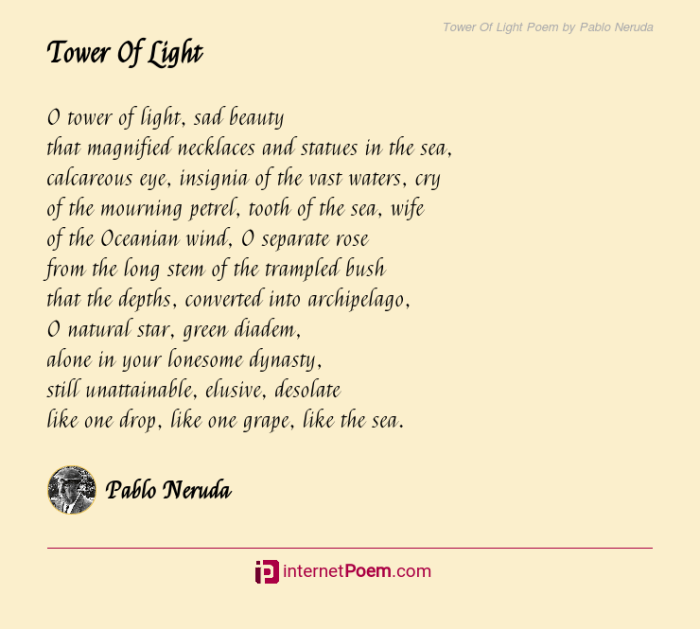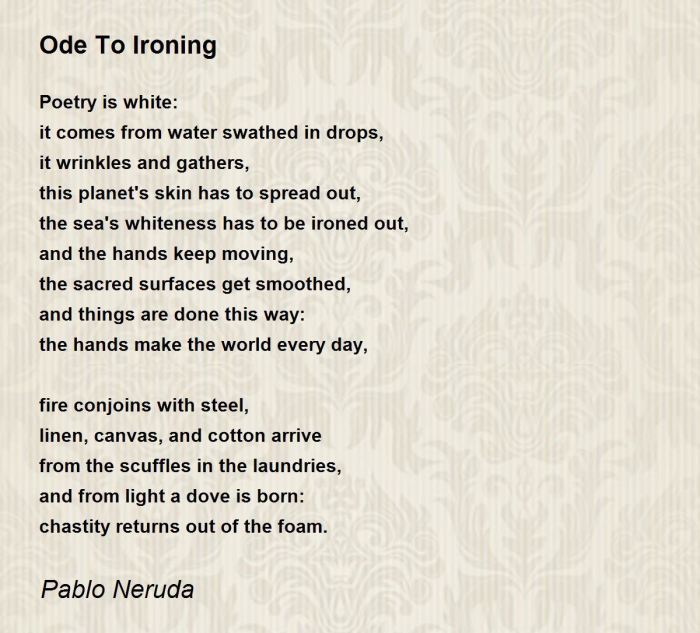Ode to enchanted light by pablo neruda – Pablo Neruda’s “Ode to Enchanted Light” is a masterpiece of modern poetry, renowned for its evocative imagery, profound themes, and innovative form. This literary analysis delves into the intricacies of this extraordinary work, exploring its rich symbolism, philosophical underpinnings, and enduring legacy.
Neruda’s ode is a testament to the transformative power of light, which illuminates both the physical and metaphysical realms. Through vivid sensory descriptions and intricate metaphors, he invites readers to experience the world anew, revealing its hidden depths and interconnectedness.
Introduction: Ode To Enchanted Light By Pablo Neruda

Pablo Neruda, a renowned Chilean poet, stands as one of the most significant literary figures of the 20th century. His evocative and surrealist style has captivated readers worldwide. “Ode to Enchanted Light,” a poem from his acclaimed collection Residencia en la Tierra(Residence on Earth), is a testament to Neruda’s mastery of language and his profound exploration of themes such as love, nature, and the search for meaning.
Exploration of Imagery, Ode to enchanted light by pablo neruda
Neruda’s poem is a symphony of vivid and evocative imagery. The poem is awash in light, which serves as a central motif and a powerful symbol of hope, renewal, and the transformative power of love. Neruda’s use of sensory details, such as the “scent of lemons” and the “sound of water,” creates a rich and immersive atmosphere that draws the reader into the poem’s world.
Themes and Motifs
The poem explores a range of themes, including love, nature, and the search for meaning. Neruda’s love for his muse, whom he addresses as “my love,” permeates the poem. His depiction of nature is equally passionate, as he finds solace and inspiration in the beauty of the natural world.
Throughout the poem, Neruda grapples with existential questions, seeking to understand his place in the universe and the purpose of human existence.
Recurring motifs in the poem include light, water, and the human body. Light, as mentioned earlier, symbolizes hope and renewal. Water, often associated with life and fertility, represents the fluidity and interconnectedness of all things. The human body, with its fragility and resilience, serves as a reminder of our mortality and the preciousness of life.
Structure and Form
The poem consists of five stanzas, each with varying lengths and rhyme schemes. Neruda’s use of free verse allows him to convey his emotions and ideas with a sense of spontaneity and authenticity. The poem is rich in literary devices, such as metaphors, similes, and personification.
These devices enhance the poem’s imagery and add depth to its themes.
Literary Context
“Ode to Enchanted Light” is part of Neruda’s Residencia en la Tierra, a collection that marked a significant shift in his poetic style. The collection reflects Neruda’s disillusionment with the world and his search for meaning in a chaotic and often incomprehensible universe.
The poem’s surrealist elements, with its dreamlike imagery and fragmented structure, align with the broader avant-garde movements of the time.
Over the years, “Ode to Enchanted Light” has received critical acclaim and has been widely anthologized. It is considered one of Neruda’s most important works and a testament to his enduring legacy as a master of 20th-century poetry.
Quick FAQs
What is the central theme of “Ode to Enchanted Light”?
The poem explores the transformative power of light, which illuminates both the physical and metaphysical realms, revealing the hidden depths and interconnectedness of the world.
How does Neruda use imagery in the poem?
Neruda employs vivid sensory descriptions and intricate metaphors to create a multisensory experience for readers, inviting them to see, hear, smell, taste, and touch the world through the lens of light.
What is the significance of the form of the poem?
The poem’s innovative form, characterized by irregular stanzas and lines, mirrors the fragmented and multifaceted nature of light, reflecting the poem’s exploration of the complexities of existence.


